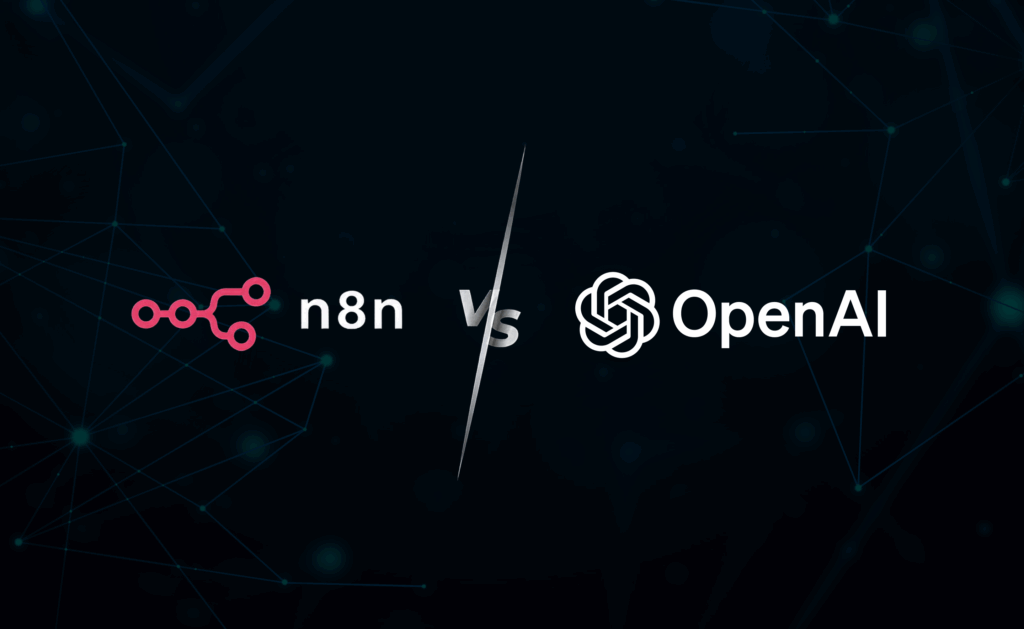The automation landscape has evolved dramatically in the past year. Business leaders now face a critical decision: should they invest in traditional workflow automation tools like N8N, or pivot to AI-native platforms like OpenAI’s Agent Builder? This choice isn’t just about technology preferences—it’s about choosing the foundation for your company’s operational future.
Both platforms promise to eliminate repetitive tasks and streamline operations, but they approach automation from fundamentally different angles. N8N offers visual workflow design with extensive integrations, while OpenAI’s Agent Builder leverages advanced AI reasoning to handle complex, dynamic tasks. Understanding which tool aligns with your business needs can save you months of implementation time and thousands in operational costs.
In this comparison, we’ll examine the strengths, limitations, and ideal use cases for both platforms, helping you make an informed decision that transforms chaos into flow.
Understanding the Core Philosophy Behind Each Platform
N8N and OpenAI’s Agent Builder represent two distinct generations of automation thinking. N8N emerged from the workflow automation era, where the primary goal was to connect disparate systems through predetermined sequences. It’s a visual, node-based platform where you design workflows by dragging and dropping components, creating a flowchart that executes specific actions when triggered. This approach offers transparency and control—you can see exactly what happens at each step, making it excellent for debugging and auditing.

Image: Conceptual side-by-side comparison of N8N and OpenAI Agent Builder on two laptops.
OpenAI’s Agent Builder takes an entirely different approach, rooted in autonomous intelligence. Rather than following rigid pathways, agents use large language models to interpret instructions, make decisions, and adapt their behavior based on context. You don’t design every step; instead, you define goals and parameters, allowing the AI to determine the best approach. This flexibility makes it powerful for tasks that involve interpretation, judgment, or dealing with unpredictable inputs.
The philosophical difference matters more than you might think. N8N excels when you need predictable, repeatable processes with clear logic. OpenAI’s Agent Builder shines when tasks require understanding nuance, adapting to variations, or processing unstructured information. Many businesses discover they need both approaches, using traditional workflow automation for structured processes while deploying AI customer agents for tasks requiring intelligence and adaptability.
Technical Capabilities and Integration Ecosystem
When evaluating automation platforms, integration depth determines what you can actually accomplish. N8N boasts an impressive library of over 400 pre-built integrations covering everything from mainstream tools like Slack and Google Workspace to specialized platforms like Airtable and WooCommerce. Each integration includes multiple actions and triggers, giving you granular control over how systems communicate. The platform also supports custom API connections, webhooks, and even allows you to write JavaScript or Python code directly within workflows when pre-built options aren’t sufficient.
| Feature | N8N | OpenAI Agent Builder |
|---|---|---|
| Pre-built Integrations | 400+ native integrations | Limited, relies on function calling |
| Custom API Support | Full REST/GraphQL support | Function-based API calls |
| Data Transformation | Visual mapping + code nodes | Natural language processing |
| Error Handling | Built-in retry logic, branching | Context-aware error recovery |
| Learning Curve | Moderate, visual interface | Lower initial, higher for optimization |
| Cost Structure | Self-hosted free, cloud paid | Token-based usage pricing |
Table: Comparative table highlighting the technical capabilities and integration ecosystems of N8N and OpenAI’s Agent Builder.
OpenAI’s Agent Builder takes a different approach to integration. Rather than native connectors, it uses function calling to interact with external systems. You define functions that describe available actions (like “send email” or “update CRM record”), and the agent decides when to invoke them based on its understanding of the task. This creates more flexible, conversational interfaces but requires more technical setup. You’re essentially building a custom API layer that the agent can access, which gives enormous flexibility but demands stronger development capabilities.
For businesses already using multiple SaaS tools, N8N’s extensive integration library often provides faster initial value. You can connect everything across your tech stack without writing extensive code. However, suppose your workflows involve processing customer inquiries, analyzing sentiment, or making judgment calls based on unstructured data. In that case, OpenAI’s natural language understanding capabilities offer functionality that traditional automation simply cannot match.
Ready to Choose the Right Automation Platform?
Get a free audit of your current processes and discover whether traditional workflow automation, AI agents, or a hybrid approach will deliver the fastest ROI for your business.
Real-World Use Cases: Where Each Platform Excels
Understanding abstract capabilities matters less than knowing what each platform actually accomplishes in practice. N8N particularly excels at operational automation where logic follows clear rules. Consider a digital agency managing client onboarding: N8N can automatically create project folders in Google Drive when deals close in CRM, generate contracts from templates, send welcome emails with scheduling links, and create tasks in project management tools. The entire sequence executes reliably every time because the logic never changes, similar to how we helped transform client onboarding workflows for one agency.

Image: Professional exploring AI agent workflows on a computer screen.
OpenAI’s Agent Builder demonstrates its value when context and interpretation become critical. A customer support agent built on the platform can understand nuanced complaints, check order status across multiple systems, determine appropriate refund amounts based on policy documents, and compose personalized responses that match brand voice. Traditional automation would require dozens of conditional branches to handle variations; the AI agent adapts naturally to each unique situation.
The distinction becomes even clearer around maintenance requirements. N8N workflows need updates when integrated systems change their APIs or when business rules evolve. Someone must manually modify the workflow, test changes, and redeploy. OpenAI agents can often adapt to minor changes through updated instructions without code modifications. However, agents require ongoing monitoring to ensure they interpret instructions correctly and don’t develop unexpected behaviors as they encounter new scenarios.
Cost Considerations and Strategic Decision-Making
Pricing models for these platforms differ so fundamentally that direct comparisons become challenging. N8N offers a self-hosted option that’s completely free if you have the technical infrastructure and expertise to deploy and maintain it. You’ll pay for server resources, but there’s no licensing fee. Their cloud offering starts at reasonable monthly rates but scales with workflow executions, making costs predictable based on automation volume.
OpenAI’s Agent Builder uses token-based pricing tied to the GPT-4 model powering the agents. Every input processed and response generated consumes tokens, making costs variable based on conversation length, complexity, and frequency. Light usage might cost under $100 monthly, but customer-facing agents handling thousands of inquiries could reach four or five figures. The unpredictability creates budgeting challenges, though costs typically correlate with value delivered.
| Usage Scenario | N8N (Cloud) | OpenAI Agent Builder |
|---|---|---|
| Small Business (1,000 executions/month) | $20-50/month | $50-200/month |
| Growing Company (10,000 executions/month) | $100-300/month | $300-800/month |
| Enterprise (100,000+ executions/month) | $500-2,000/month | $2,000-10,000/month |
Table: Compartative of cost structures and usage scenarios for N8N cloud and OpenAI Agent Builder.
Hidden costs deserve equal attention. N8N requires someone with workflow design skills to build and maintain automations. If you don’t have this expertise in-house, you’ll need external consultants or a significant training investment. OpenAI agents demand different skills—prompt engineering, function design, and behavioral tuning—that may not exist in traditional IT teams. This is why many organizations explore fully managed automation services to bridge the expertise gap.
The total ownership calculation should factor in opportunity costs as well. How quickly can you deploy automations that deliver business value? How much manual work will they eliminate? A comprehensive approach to building an automation culture considers not just tool costs but the entire economic impact of transformation.
Making the Right Choice for Your Business Context
The decision between N8N and OpenAI’s Agent Builder shouldn’t be an either-or proposition for most organizations. The smartest automation strategies often employ both tools strategically. Use N8N for the backbone of your operations—connecting systems, moving data, triggering actions based on events, and ensuring reliable execution of routine processes. Deploy OpenAI agents where human-like understanding, flexibility, and communication add unique value.

Image: Conceptual graphic representing workflow automation and AI agent platforms.
Consider starting with N8N if your immediate needs involve connecting existing tools, automating data transfers, or eliminating manual steps in well-defined processes. The platform’s maturity, extensive integrations, and predictable costs make it ideal for building a solid automation foundation. You’ll see ROI quickly with workflows that save hours of repetitive work each week.
Choose OpenAI’s Agent Builder when your challenges involve unstructured data, customer communication, content generation, or tasks requiring contextual judgment. An AI agent that qualifies leads through natural conversations or analyzes customer feedback for sentiment patterns delivers value that traditional automation cannot replicate. The LeadQualify Agent approach demonstrates how AI-powered automation transforms customer engagement.
For most SMEs and growing companies, the winning strategy involves hybrid implementation. Start with quick wins using whichever platform addresses your most pressing pain points. Build confidence and capability with initial projects, then expand your automation portfolio strategically. Document what works, learn from what doesn’t, and continuously refine your approach based on real business outcomes rather than technology trends.
Moving Forward: Your Next Steps in the Automation Journey
Choosing between N8N and OpenAI’s Agent Builder ultimately depends on your specific business context, technical capabilities, and strategic objectives. Neither platform represents a universally superior choice—each excels in different scenarios. The most successful automation initiatives start with clear objectives and realistic expectations rather than technology-first thinking.
Begin by auditing your current processes to identify automation opportunities. Which tasks consume disproportionate time relative to their value? Where do bottlenecks slow down operations? What manual work frustrates your team most? The answers to these questions should guide your platform selection more than feature checklists or pricing comparisons. Tools exist to serve business outcomes, not the other way around.
Remember that automation is a journey, not a destination. Your first workflows won’t be perfect, and that’s completely normal. Start small, iterate quickly, and scale what works. Whether you choose N8N’s structured workflows, OpenAI’s intelligent agents, or a combination of both, the goal remains the same: transforming operational chaos into productive flow that lets your team focus on work that truly matters.
Transform Your Operations With Expert Guidance
Not sure where to start? Schedule a free consultation with our automation specialists to map your unique automation roadmap and identify the quickest path to measurable results.






